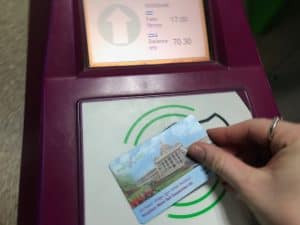I am no stranger to metro systems. I’ve up hiked the spiral staircases of Paris’ metro, impatiently waited in a dark tunnel when my line broke down while on the London Tube, poured buckets of sweat in the graffiti adorned underground train to Rome’s neighboring beach town, fervently watched street performers in the bowels of Washington D.C.’s network of underground metro tunnels and have spent much of my time riding my own city’s eccentrically named Seattle Link Light rail through canopies of tree cover and rain specked windows. I have traveled some of the biggest cities of the world on the fast track in oblong shaped train cars, stumbling, scrimmaging and shoving my way through different countries. I thought I had done it all when it came to metro riding until I came to Bengaluru.
I’ll admit Bengaluru’s metro system is not entirely special or outstanding in anyway, which is why it’s my favorite metro I’ve ever ridden. It’s relatively clean, easy to navigate, the stations are spacious, its convenience is obvious and the employees are very helpful. It’s exactly what a foreign traveller wishes for when scoping out public transport in a new city.
The metro is a surprising way of sightseeing
My favorite part about riding metros is that it’s a surefire way to get your bearings. Studying the maps, stops and timetables gives me an idea of how a city is mapped out and how to get from point A to point B. Not to mention riding the metro is a great way to see a city from a different perspective. Nothing compares to the feeling of pushing yourself against the Plexiglas window watching the colours of a city rush past you. Even though I take the same route everyday I see something new each time and find myself googling a neighborhood to know more about whatever it was that caught my eye.
While being crammed into a car with hundreds of complete strangers, with barely enough air to go around is not the most pleasant situation it is a great way to feel less like an observer and more of a participant in a new city. Everyday in Bengaluru I push my way through crowds of strangers who rightfully push me back as we ride to our respected locations. I ride alongside business people aggressively typing out texts, giggling school children, backpack-clad college students, women with grocery bags, men talking on the phone, young couples tightly gripping each others’ hands and teenagers with music blaring out their earphones. There is no touristy glamour, forced sightseeing or a veil between them and me. For a second I feel slightly less of an outsider.
Another aspect I like about the Bengaluru metro is that it continues to surprise me. Before I had stepped foot into a metro station in Bengaluru I thought it would be insanely crowded and hectic. Like the type of crowded that wouldn’t require me to walk and instead be carried along by the moving crowd, the type of crowded that would make it difficult to even shove my way into the train car and never having enough room to make my way to the opposite door. But fortunately the crowds are not as bad as I expected a metropolitan city with a population of ten million to be.
I am also surprised at the short clips that play on the platform televisions and in the cars. They are cliché and universally understood. I’ve watched the one with the little girl picking up waste and a man helping her throw it away so many times never listening or reading the dialogue, but it’s exactly what I would expect to see on any metro around the world that I don’t need to know what is actually being said. It’s like small cultural differences have been dissolved while on the metro.
Finally, I find it surprising that the English speaking recorded voice that announces the station name and which door will open is a man with a slight British accent. I honestly thought it would be a man or woman with an Indian accent and I am surprised by this voice every time.
Riding the metro: A lesson in confidence
Riding the metro in Bengaluru is a huge confident boost. I remember the day I felt confident enough to make my entire trip by myself. The ease of walking through the security check, up the escalator, scanning my metro card and finding the right platform on my own is something I take for granted while in my own city’s metro. There is no better feeling in the world than breezing through Bengaluru’s metro stations with the look in my eye that I know where I’m going and how to get there.
One of my proudest moments happened last weekend when a friend and I were near UB City and had to find the closest metro station to get back to our flat. After studying the station map, my friend said we would have to switch from the purple line to the green line, adding that she had never made the switch before. I proudly exclaimed that I had done it many times on my ride to and from work. I had finally proved to myself that my metro riding skills had advanced to navigating the more complex routes.

Pic: Kennedy Wirth
My metro card has fast become one of my favorite mementos from my time in Bengaluru. Right now it tells me I have become the smallest bit a part of this city and when I look back on my time living, working and navigating Bengaluru my metro card will remind me of everything I experienced thanks to public transportation and the independence I felt while zipping through a very foreign city on my own.